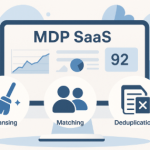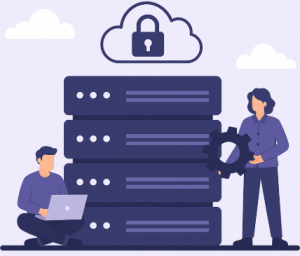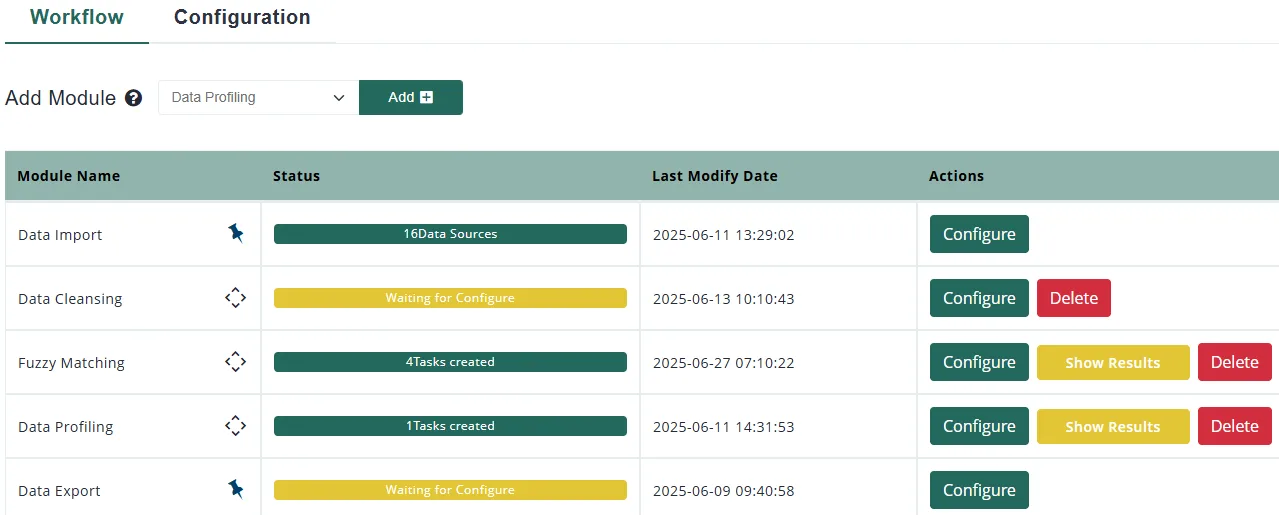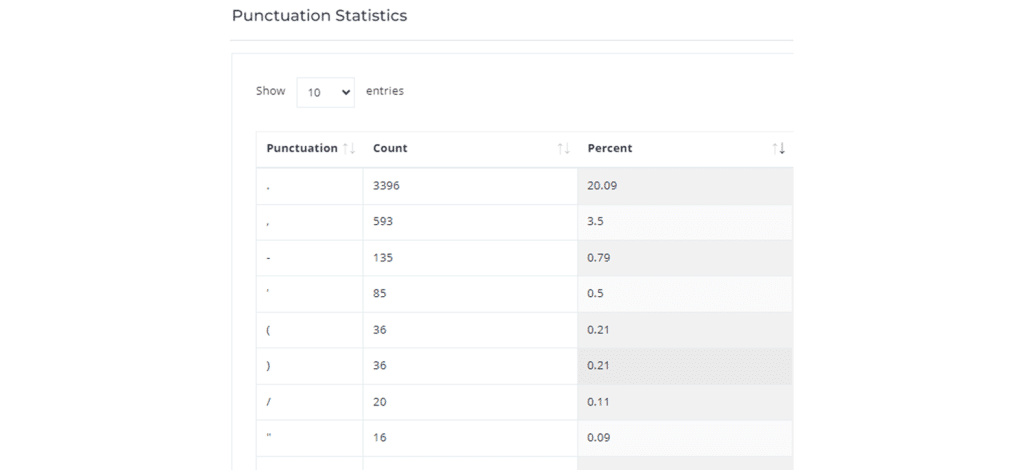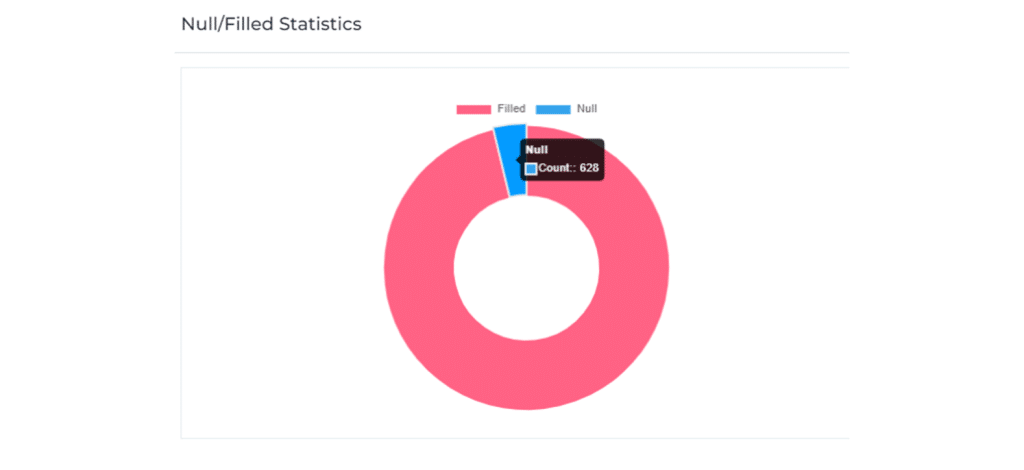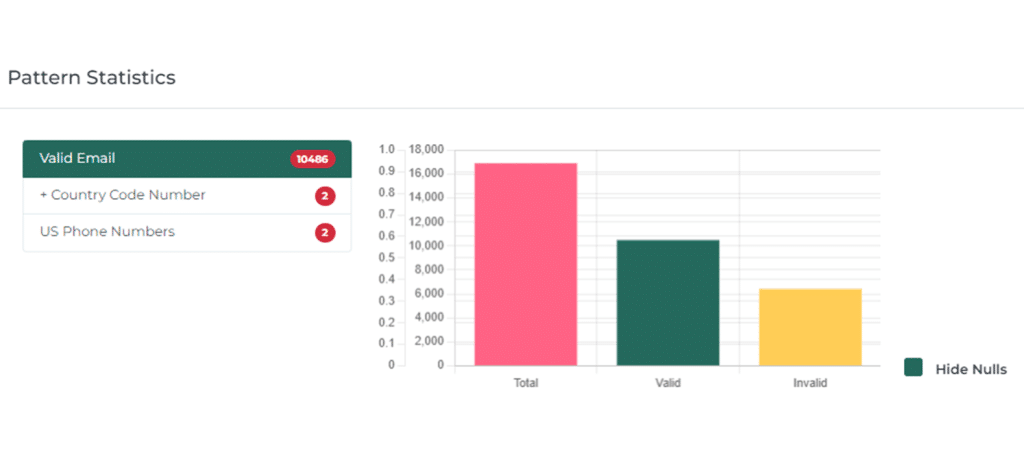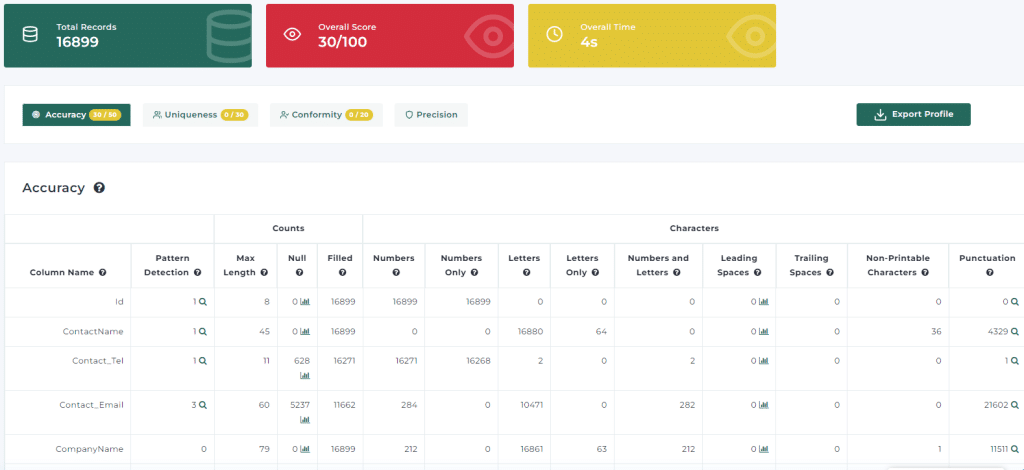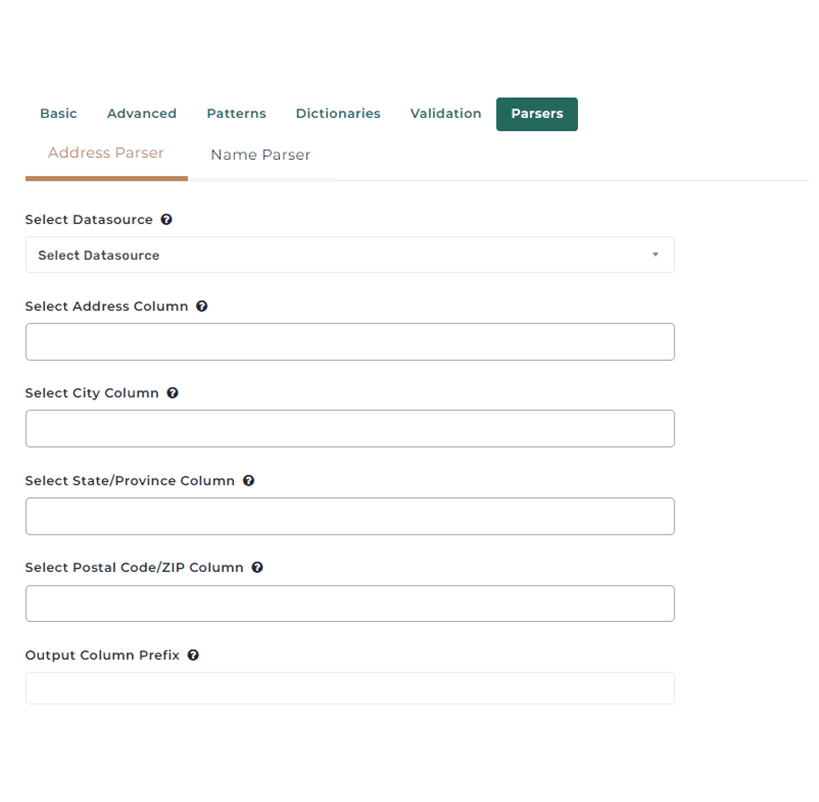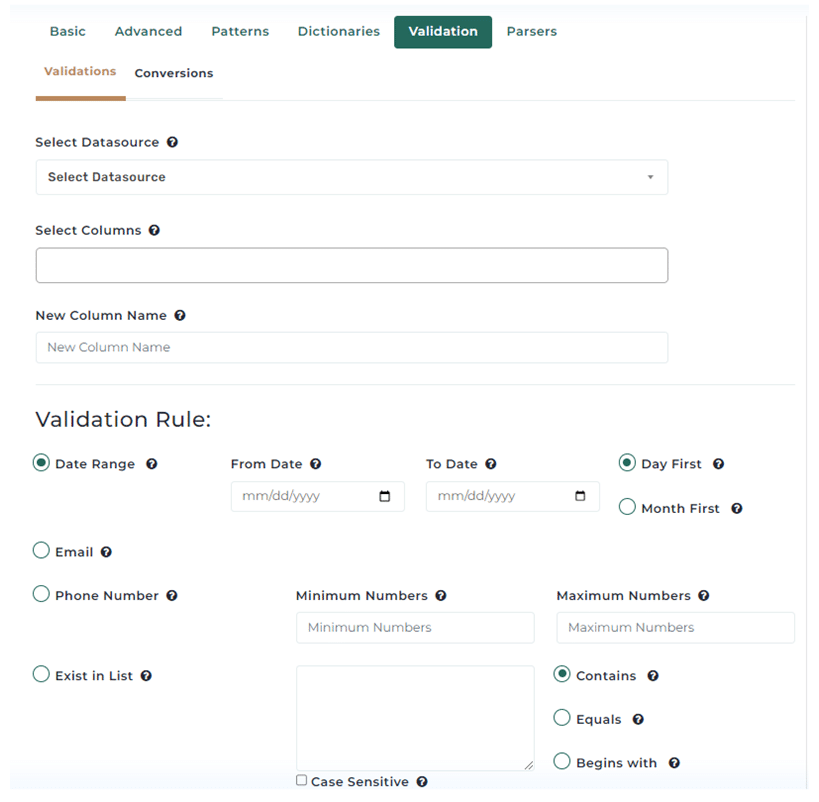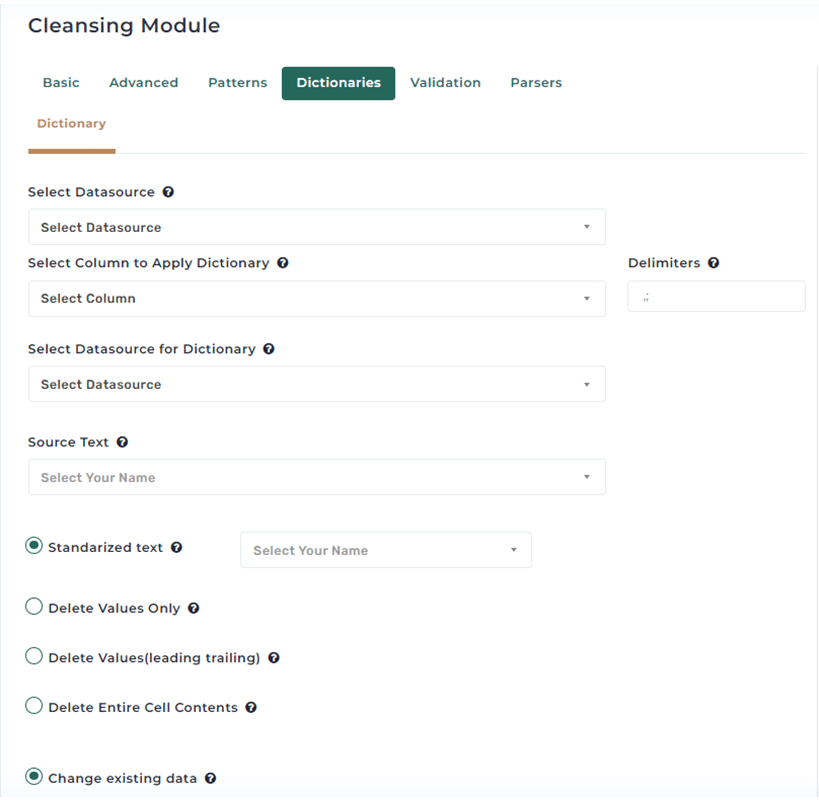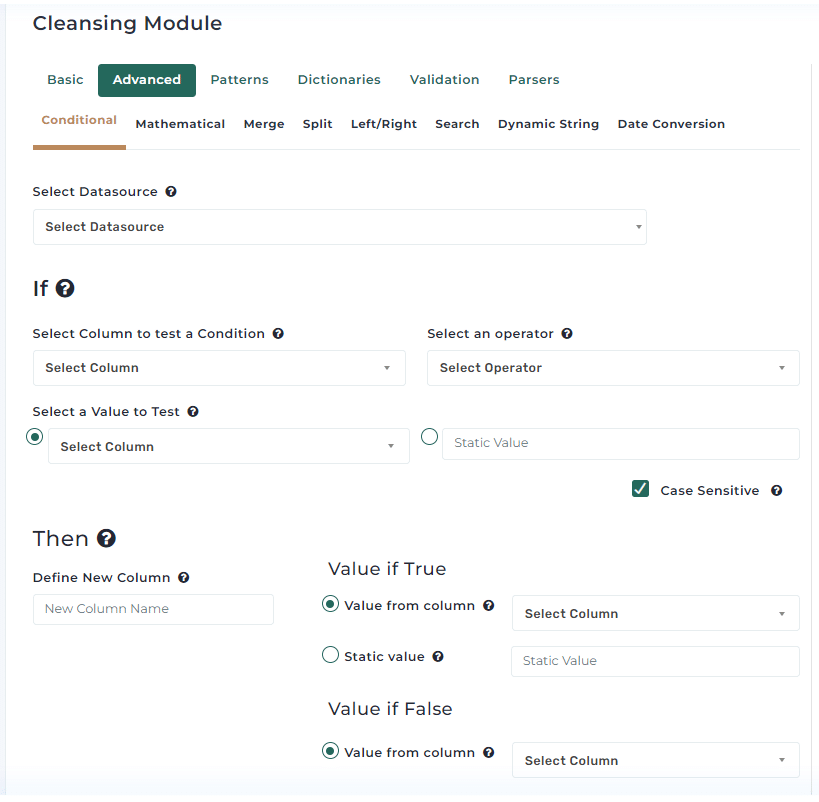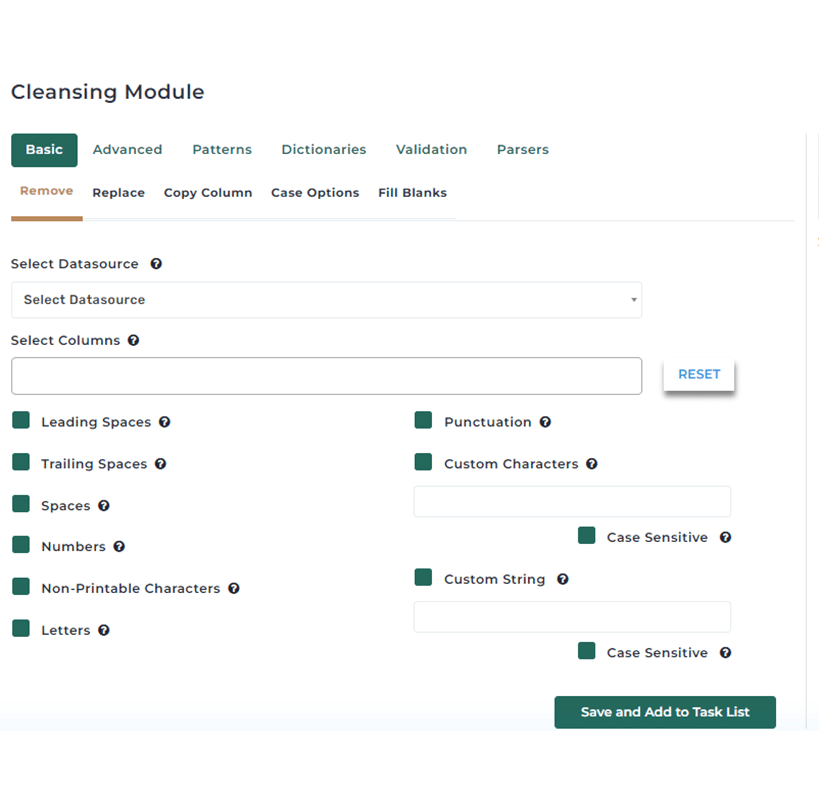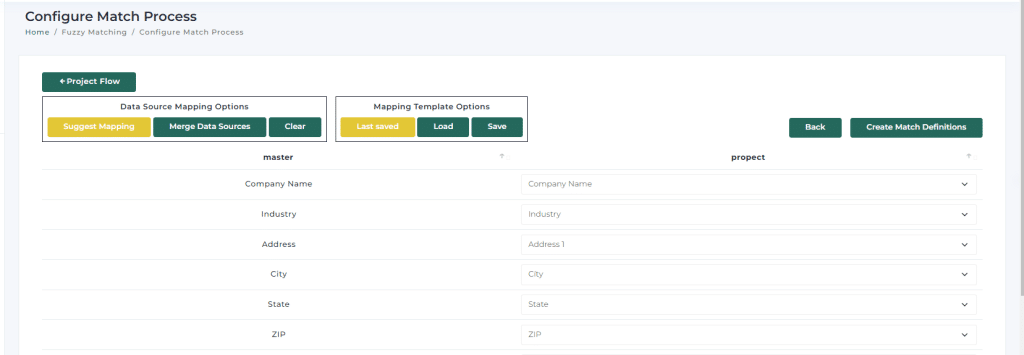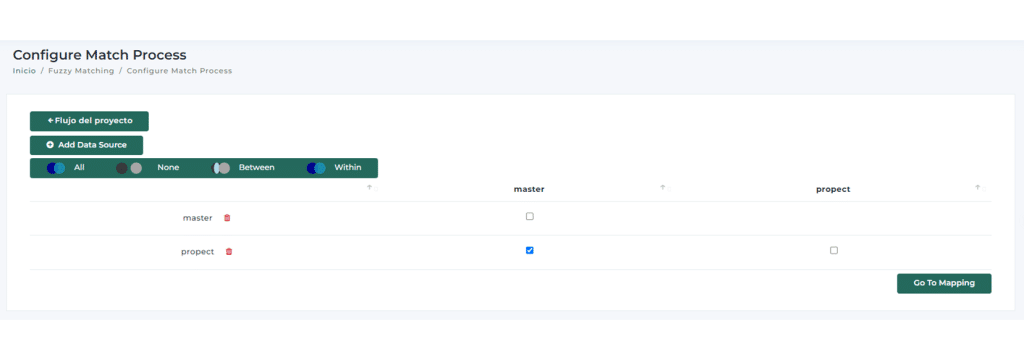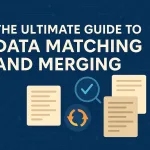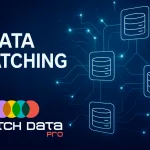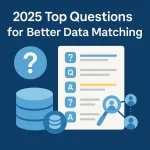The #1 Data Qualtiy Management Platform for Matching, Cleansing, and Merging Data
Match Data Pro unifies all your data processes into one intelligent data quality platform. Easily profile, cleanse, and match records across files, databases, and systems. Built for accuracy and scale, it uses advanced algorithms and AI-ready fuzzy matching to detect duplicates, fix inconsistencies, and merge clean, reliable datasets.
Opciones de despliegue de Match Data Pro
SaaS (Alojamos)
On-Premise/Nube privada
(Usted aloja)
Enterprise-Grade AI Fuzzy Data Matching
- Concordancia flexible basada en reglas para obtener la máxima precisión.
- AI powered match definition suggestions
- Identifique y elimine los duplicados en cuestión de segundos con una deduplicación sencilla.
- Correspondencia difusa entre fuentes de datos ilimitadas
- Sobrescribir y fusionar datos dentro de grupos y crear un Golden Record
- Ajuste de la correspondencia de datos con puntuación y agrupación de correspondencias patentadas
- Herramientas integradas de gestión de calidad de datos
- AI match results validation for edge cases
Nuestras opciones avanzadas de limpieza le ayudan a seguir las mejores prácticas de limpieza de datos con el fin de normalizarlos para su deduplicación.
Nuestro software de cotejo difuso está optimizado para el rendimiento: procesa grandes volúmenes de datos de forma rápida y eficaz sin superar los límites de memoria.
Gestión de datos basada en proyectos
- Importación y exportación de datos sin fisuras con conectores para bases de datos en la nube, archivos, JSON, Google Drive, Dropbox, OneDrive, SQL y archivos ZIP.
- Solución integral de perfilado de datos para analizar nulos, patrones, tipos, duplicados y anomalías: mejore la calidad de los datos antes de cotejarlos o limpiarlos.
- Potente limpieza de datos con las mejores prácticas de normalización, estandarización, formateo y eliminación de errores para preparar los datos para el cotejo.
- Software avanzado de concordancia difusa para detectar registros similares mediante una lógica personalizable, ideal para la deduplicación, la concordancia de datos y la resolución de entidades.
Reseñas y detalles del producto de Match Data Pro
En G2.com
"Resuelto el problema de la correspondencia compleja de datos difusos"
Director de Tecnología para Mercado Medio (51-1000 empleados)
¿Qué es lo que más te gusta de Match Data Pro?
El proceso paso a paso que guía al usuario a través del proceso de emparejamiento. El proceso sigue un patrón lógico para que el resultado final sea correcto. El emparejamiento de datos difusos es complejo y presenta múltiples permutaciones, pero Match Data Pro ha podido adaptarse a la complejidad de mis conjuntos de datos. Al ser un producto SaaS y local, dispongo de opciones según el usuario y el conjunto de datos. El equipo fue muy servicial durante la incorporación y la formación.
¿Qué problemas resuelve Match Data Pro y cómo le beneficia?
Emparejamiento de múltiples conjuntos de datos de manera oportuna y confiable.
He estado usando la plataforma durante aproximadamente 12 meses y debo decir que es muy fácil de usar.
Consultor Senior ERP Empresa (> 1000 emp.)
¿Qué es lo que más te gusta de Match Data Pro?
Cuenta con todas las herramientas necesarias para tus datos: creación de perfiles, limpieza, lógica difusa y mapeo. Mi favorita es la velocidad con la que la herramienta te permite estar lista y lista para usar en menos de un minuto para crear perfiles de datos.
La mayoría de las demás aplicaciones requieren una gran configuración y una curva de aprendizaje enorme.
La otra cosa es que el precio es muy fácil y claro.
Ben y James han sido excelentes al brindar apoyo y ayudar en lo que han podido.
¿Qué es lo que no te gusta de Match Data Pro?
Un poco más de videos de capacitación, pero estos ya están en producción y hay algunos más por salir.
¿Qué problemas resuelve Match Data Pro y cómo le beneficia?
Proporciona datos limpios con gran rapidez. Esto requiere el uso habitual de hojas de cálculo y causa retrasos, ya que los datos se procesan línea por línea. Sin embargo, con MDP se puede ver el conjunto completo de datos. Se captura cada campo y se proporciona un estado. También es fácil ver los errores con una vista rápida del archivo que muestra los datos reales.
No se necesita registro ni tarjeta de crédito
Si tiene alguna pregunta, póngase en contacto con nosotros.
Pruebe ahora nuestro cotejo de datos difusos
Vea una demostración
Qué puede hacer
con
Match Data Pro
Match Data Pro no se limita a la comparación de datos difusos de primera clase, sino que está diseñado para simplificar los flujos de trabajo de datos complejos y hacerlos más inteligentes y colaborativos. Esto es lo que puede esperar
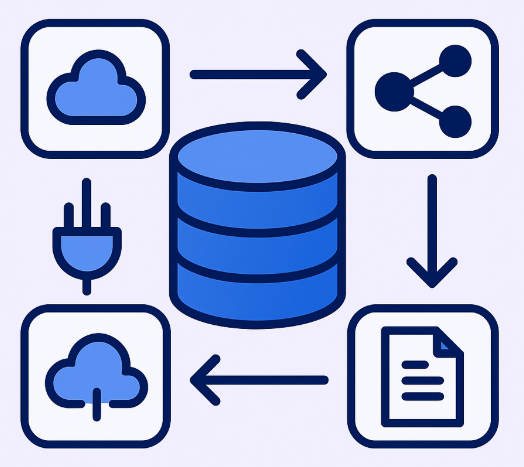
Conecte y sincronice sin problemas datos de diversas fuentes, incluso de sistemas incompatibles,
para permitir una integración de datos unificada, automatizada y en tiempo real
.

Nuestras API e integraciones en la nube le permiten conectarse con las principales plataformas: Snowflake, Google Drive, OneDrive, Dropbox y otras fuentes de datos.
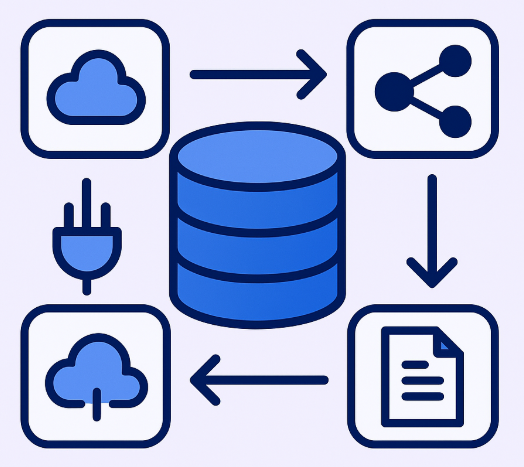
Aproveche los conectores prediseñados que funcionan con prácticamente cualquier formato de archivo o estructura de datos.

Administre todas sus integraciones y flujos de trabajo de datos desde un panel limpio e intuitivo, sin necesidad de codificación.
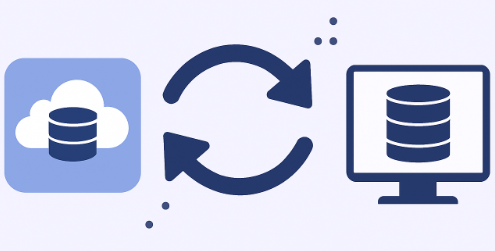
Mantenga sus datos sincronizados con las herramientas integradas de replicación y sincronización.

Encuentre y solucione rápidamente los problemas de datos
utilizando las herramientas integradas de
para crear perfiles, limpiar,
y supervisar la calidad de los datos.

Cree rápidamente vistas de 360 grados de sus clientes, proveedores o cualquier entidad comercial utilizando fuentes internas y externas.

Estandarice, limpie y elimine duplicados de registros a escala con reglas que evitan que datos incorrectos ingresen al sistema.
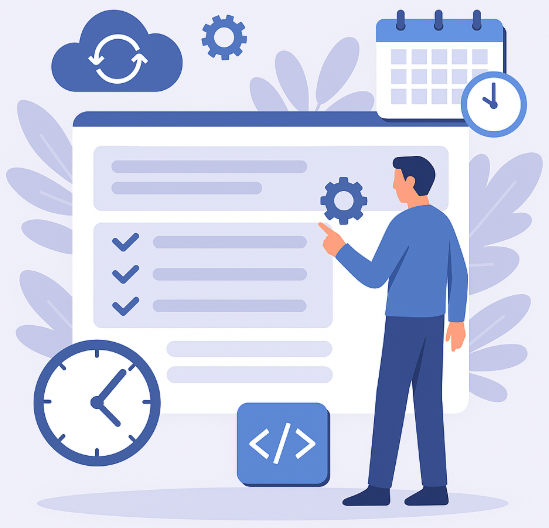
Automatice todo su proceso con flujos de trabajo fáciles de usar, reglas reutilizables, control de versiones, programación, webhooks y activadores de API REST.

Trabaje mejor en equipo asignando diferentes niveles de acceso y compartiendo flujos de trabajo de proyectos de forma segura en toda su organización.
Discover Deep Data Insights
with Our AI Profiling Tool
Obtenga información de gran alcance sobre los datos con nuestra herramienta avanzada de creación de perfiles. Con más de 25 métricas clave, le permite analizar a fondo la calidad de los datos y descubrir los problemas que deben abordarse. Nuestra herramienta proporciona un análisis detallado para ayudarle a identificar incoherencias y anomalías de forma eficaz.
Enhance your data management with a professional AI summary of your data. Customize a report in seconds, and easily create actionable insights using AI.
AI Data Cleansing & Standardization
Transforme sus datos con facilidad
Libere todo el potencial de sus datos con nuestras herramientas de limpieza de mejores prácticas. Tanto si necesita normalizar los datos para informes específicos como garantizar que cumplen estándares de alta calidad, nuestro software de limpieza de datos irá más allá.
Limpieza de datos sin esfuerzo
Diga adiós a los errores e incoherencias en los datos. Nuestra sencilla interfaz de apuntar y hacer clic le ayuda a limpiar y normalizar sus datos de forma eficaz. Con más de 20 opciones personalizables, puede asegurarse de que sus datos son precisos, fiables y están listos para el análisis.
Ahorre tiempo con reglas reutilizables
¿Gestiona 10 fuentes de datos con los mismos problemas de calidad? Aplique sus reglas de limpieza de datos de una fuente a todas las demás en cuestión de segundos.
Auto-Create Rules with AI
Automatically clean your data by letting AI read your data profile and determine exactly what must be cleansed. Clean large data sets in seconds.
Coincidencia precisa y configurable de datos difusos para sus datos
Consiga una coincidencia precisa de datos difusos con nuestra herramienta avanzada y configurable. Nuestro algoritmo personalizado gestiona pequeñas variaciones eficazmente mediante múltiples definiciones (declaraciones OR) y criterios (declaraciones AND) para garantizar una alta precisión. Compare sin problemas hasta un millón de registros en menos de 5 minutos, lo que lo hace perfecto para grandes conjuntos de datos.
Comparación de datos Características principales
Optimice su proceso de comparación de datos con nuestra potente herramienta de comparación de datos difusos.
Alta precisión
Se ha demostrado que nuestra lógica de emparejamiento y agrupación consigue más coincidencias que la competencia.
Configuración personalizada
Configure múltiples definiciones y criterios en ordet para cotejar datos incompletos e incoherentes.
Agrupación propietaria
La agrupación de partidos es importante cuando se necesita un resultado específico. Hemos desarrollado opciones que satisfacen las necesidades de cada caso de uso.
Opciones de puntuación
Somos la única herramienta del sector que ha desarrollado opciones de puntuación. Esto le permite ver la puntuación de la relación de múltiples maneras.
Procesamiento rápido
Compare hasta 1 millón de registros en menos de 5 minutos.
Automatización de proyectos
Interfaz fácil de creación de empleo
Match Data Pro guarda la configuración del proyecto, no los datos, para que pueda actualizar los datos de forma segura y reutilizar o volver a ejecutar los procesos bajo demanda. Es perfecto para tareas recurrentes como la deduplicación de clientes potenciales a partir del envío de formularios, la incorporación de listas o la correspondencia de múltiples fuentes.

Optimice la actualización de sus datos
Elimine el trabajo manual repetitivo con la automatización programada. Una vez configurado el proyecto, Match Data Pro le permite guardar la lógica, actualizar los datos y programarlo para que se ejecute automáticamente a los intervalos que prefiera.

Activar trabajos sin problemas
Tome el control total de sus flujos de trabajo de datos con nuestra potente API REST. Active trabajos guardados mediante programación, automatice la ejecución más allá de las ejecuciones programadas e integre Match Data Pro directamente en sus herramientas o aplicaciones internas.

Ejemplos de casos de uso de cotejo de datos
- Deduplicación de clientes entre sistemas: Identifique y fusione registros de clientes duplicados de distintos sistemas.
- Migración de CRM: Estandarice y haga coincidir los registros al realizar una migración de datos CRM.
- Detección de fraudes y análisis de riesgos: Identifique registros sospechosamente similares que puedan indicar fraude o manipulación de datos.
- Migración de datos y consolidación de sistemas: Estandarice y haga coincidir los registros al realizar una migración de datos CRM.
- Depuración de clientes potenciales en Marketing Automation: Haga coincidir y fusione clientes potenciales similares para garantizar la precisión de la segmentación y los informes.
- Cotejo de pólizas de seguros: Identifique pólizas duplicadas o solapadas con pequeños errores de introducción de datos.
- Cotejo de medios y atribución de derechos de autor: coteje los nombres de los colaboradores y las obras en las bases de datos musicales, editoriales y cinematográficas con los informes de reproducción de los consumidores.

Consulte nuestros últimos artículos
The Ultimate Guide to Data Matching and Merging
The Ultimate Guide to Data Matching and Merging in 2025 Matching and merging data is at the heart of every…
What Is Data Matching? A Simple Guide with Examples
What Is Data Matching?A Simple Guide with Examples Modern businesses collect data from everywhere—CRMs, websites, billing systems, marketing tools, spreadsheets,…
2025 Top 10 Questions for Better Data Matching
2025 Top Questions for Better Data Matching What is a data match? A data match occurs when two or more…
Vamos a empezar
¿Estás listo para ver cómo Match Data Pro puede simplificar tus operaciones de datos?
Preguntas frecuentes
Can Excel do fuzzy matching?
Yes. Excel supports basic fuzzy matching through the Fuzzy Lookup Add-In, which compares text values using similarity algorithms. However, it’s limited in performance and not ideal for large datasets or complex matching logic.
What is an example of fuzzy data?
Fuzzy data refers to information that isn’t exact, such as misspellings, abbreviations, or inconsistent formatting.
Example:
“Jon Smith,” “John Smyth,” and “J. Smith” all represent the same person but differ slightly in spelling or structure.
Can you fuzzy match in SQL?
Yes. SQL can perform fuzzy matching using functions like SOUNDEX, DIFFERENCE, or through string similarity algorithms such as Levenshtein distance or Jaro-Winkler. However, native SQL is not optimized for fuzzy comparison at scale.
What is fuzzy matching in AML?
In Anti-Money Laundering (AML), fuzzy matching is used to detect potential matches between individuals or entities across global watchlists. It helps identify variations in names, addresses, or organizations that could indicate hidden or high-risk relationships.
What is better than fuzzy matching?
Fuzzy matching can be enhanced with entity resolution or hybrid AI-assisted approaches that combine rule-based matching, phonetic algorithms, and contextual data comparison for higher accuracy and fewer false positives.
What is the meaning of fuzzy data?
Fuzzy data means information that is not clearly defined, structured, or consistent. It may contain errors, missing values, or uncertainty that makes exact matching difficult. Fuzzy techniques are used to interpret this data more intelligently.
What is another name for fuzzy matching?
Fuzzy matching is also known as approximate string matching, probabilistic matching, or similarity matching. All these terms describe methods that identify records that are close but not identical.
What is the FCM technique?
FCM stands for Fuzzy C-Means clustering, an algorithm that groups data points based on degrees of membership rather than hard assignments. It’s widely used in machine learning and data segmentation.
What is the difference between exact matching and fuzzy matching?
Exact matching identifies records that are identical across fields, while fuzzy matching allows for partial matches based on similarity scores. Fuzzy matching is more flexible, ideal for messy or inconsistent data.
What are the three types of clustering?
The three main types of clustering are:
Hard clustering – assigns each data point to one group.
Fuzzy clustering – allows data points to belong to multiple groups with probabilities.
Hierarchical clustering – builds nested clusters based on data similarity.
What is a fuzzy database?
A fuzzy database manages imprecise or uncertain information using fuzzy logic. Instead of strict true/false conditions, it stores and processes degrees of truth, allowing more flexible data querying and analysis.
How does fuzzy finding work?
Fuzzy finding works by comparing text or strings using similarity metrics like Levenshtein distance or token-based algorithms. These determine how closely two strings resemble each other and assign a similarity score.
Can AI improve fuzzy matching accuracy?
Yes. AI can enhance fuzzy matching by learning contextual patterns and optimizing thresholds. Instead of relying on static similarity scores, AI-driven systems adapt based on the type and structure of data being compared.
What is the role of fuzzy logic in data analysis?
Fuzzy logic helps handle ambiguity in data analysis. It assigns degrees of similarity instead of binary true/false results, allowing analysts to identify patterns and relationships that strict logic would miss.
How do you measure similarity between strings?
Common methods include:
Levenshtein Distance – counts character edits needed.
Jaro-Winkler – focuses on matching prefixes.
Cosine Similarity – compares vectorized text data.
These techniques output a similarity score between 0 and 1.
What causes fuzzy matching errors?
Errors occur when thresholds are too loose or strict, or when the data contains abbreviations, inconsistent formats, or missing context. Proper preprocessing and tuning improve accuracy.
How is fuzzy matching used in marketing?
In marketing, fuzzy matching identifies duplicate leads, merges customer profiles, and aligns multi-source campaign data — enabling cleaner CRM systems and better segmentation.
Is fuzzy matching scalable for big data?
Traditional fuzzy matching libraries struggle with scalability because of their computational cost. Efficient implementations use distributed processing or pre-grouping to handle millions of records.
What industries rely most on fuzzy matching?
Industries that depend heavily on data accuracy — such as healthcare, finance, government, and retail — use fuzzy matching for deduplication, fraud detection, and customer identity resolution.
